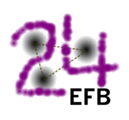Speaker
Description
On the three-body kinematics, the author proposed a $general$ $particle$ $\it{transfer}$ (GPT) potential which appears, not only at the three-body break-up threshold, but also at the quasi two-body threshold.The new potential represents a Yukawa-type potential for shorter range,but a $1/r^n$-type potential for longer range. The longer range part of the GPT potential for $n=1$ indicates an attractive Coulomb-like or a gravitational potential. While, $n=2$ includes the Efimov-like potential. The GPT-potential implies the existence of Efimov-like states in the hadron systems. In order to confirm the GPT potential, we investigate the possibility of lanthanum (La)-nucleus creation via the ${\it ultra low energy reaction}$ Cs(2d,$\gamma$)La on the three-ion quasi-molecule
CsD$_2$ in the CsD$_2$Pd$_{12}$-cluster where D-Cs-D (d-Cs-d) three-body bound states and wave functions are calculated. The ${\it wave function overlap}$ value (WFO: $W_{n,m}$) between the La highest nuclear excited state with the quantum number $n=5$, and the lowest CsD$_2$ quasi molecular modified states with the quantum number $m=6$ is of critical importance for the existence of the electro-magnetic (EM) transition in the Cs(2d,$\gamma$)La reaction. We found that the $W_{5,6}$ value is very sensitive to the nuclear potential tail with a two- or three-body $1/r^2$-type long range hadron potential. It gives the ratio: $W_{5,6}^L/W_{5,6}^S\approx 10^7$, where $W_{5,6}^L$ is given by the nuclear force with the long range GPT potential, and $W_{5,6}^S$ is obtained by the usual short range nuclear potential. The ratio corresponds to the E2-transition ratio, where the E1-transition is forbidden in this reaction.This fact means that the quasi molecular state is stable only for the short range nuclear potential, but the nuclear synthesis occurs for the short range nuclear potential with the GPT long range potential. We can conclude that if the reaction occurs, then the GPT potential is confirmed.

